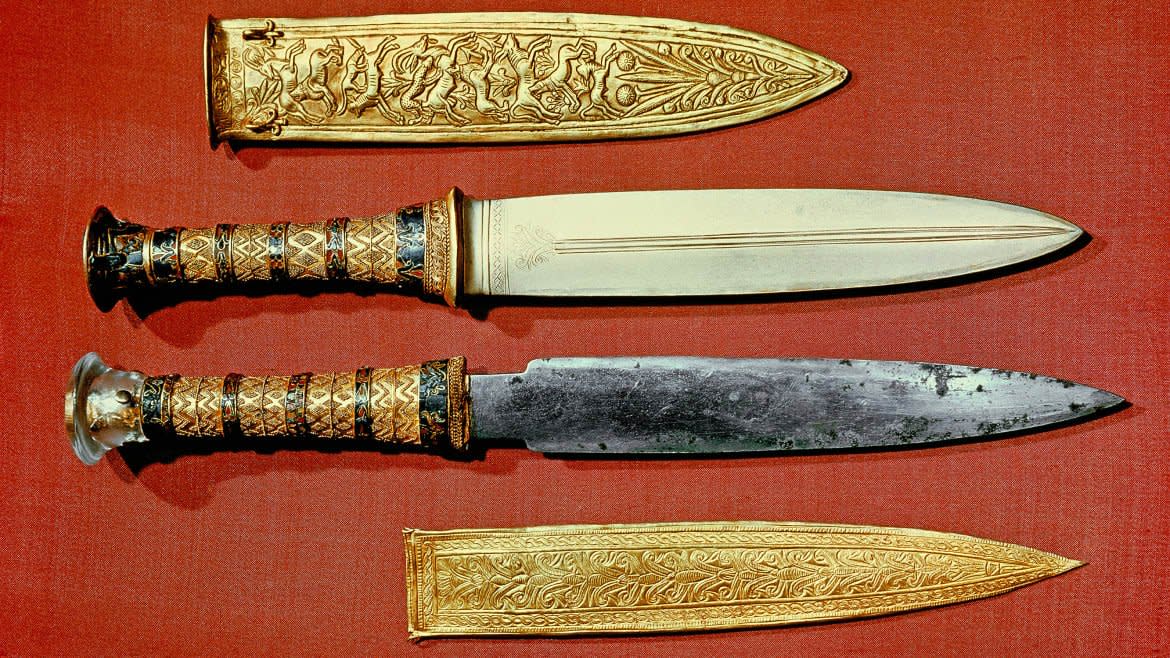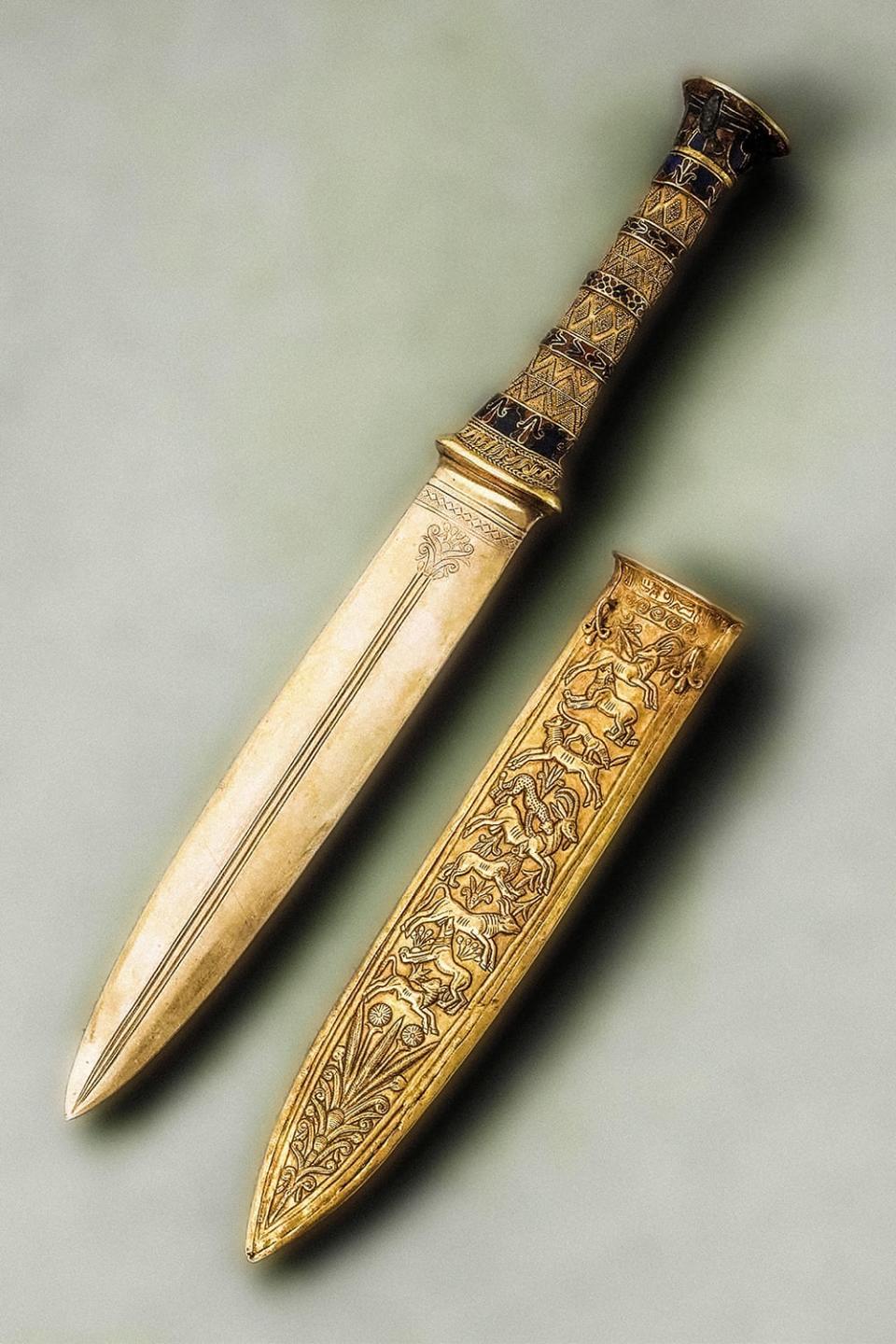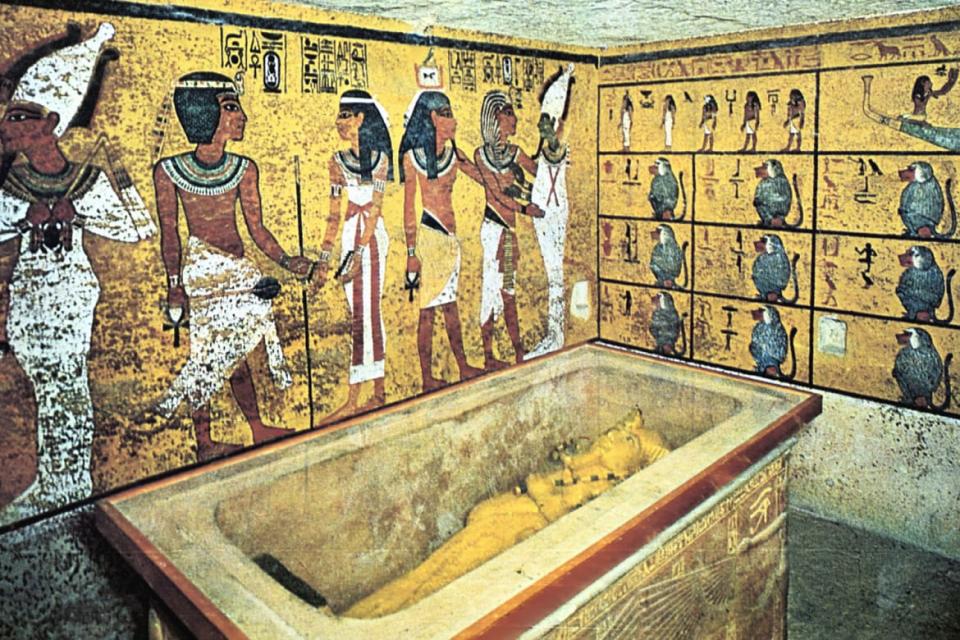King Tut’s Alien Dagger Conspiracies Have Gotten Insane

In 1925 Howard Carter entered the tomb of Tutankhamun unleashing a fictional curse, a photogenic boy-Pharaoh, and a new wave of Egyptomania upon the world. As beguiling as his iconic death mask is, it was not the only striking object in his tomb. Tucked among his burial wrappings were two exquisitely made daggers: one made entirely of gold and a second with a gold hilt and a metal blade. Unusually, the iron dagger is more valuable. This is because when King Tut was buried during the 18th Dynasty (around 1352 B.C.), the smelting technologies that allowed people to heat iron had yet to be discovered. Where did the dagger come from? It was a mystery that recent research may have solved.
The blade of the dagger is made of a kind of rust-resistant iron. The beautiful, decorated sheath and hilt reveal an extraordinary level of craftsmanship. Given that contemporaries of Tutankhamun could not make iron themselves the iron must come from somewhere else. And so, for some time archaeologists have assumed that the dagger had extraterrestrial origins. For scientists what that means is that blade was constructed out of a metallic meteorite that was discovered nearby. Even before the Iron Age began, circa 1200 B.C., humans had been pounding implements out of space iron. And, thus, it was reasonable to suppose that the “dagger from outer space” was constructed out of this valuable yet rare ancient resource.

Two recent studies, which utilize the most recent non-invasive technologies, confirm that the iron used in the blade comes from a meteorite. In an article published in the journal Meteoritics and Planetary Science a team of scholars based in Japan and Egypt argue that the meteoric blade was manufactured using low-temperature forging (<950 °C). The authorial team of the soon-to-be-released book Iron from Tutankhamun’s Tomb agree.
Where the two studies disagree is the place of production. The first team argue, based on an analysis of the famous Amarna papers (a collection of records found in Armana, Egypt), that the blade was manufactured in ancient Anatolia, modern Turkey. The Armana papers suggest that that at least one dagger was gifted to Amenhotep III by Tushratta the King of Mittanai. The second team are less confident about the dagger’s place of manufacture. They note that the blade’s pommel is similar to other objects from the Aegean Sea but that the stye of dagger is typically Egyptian. They posit that it was either made in Egypt or abroad for an Egyptian market. They conclude, “As a result, [that] no clear overall picture on the origin of the dagger’s handle and blade” can be ascertained. Other experts contacted by Live Science threw other complicating details into the mix and argued that perhaps the blade and hilt were produced separately.
So far, we have the making of an interesting but unremarkable academic conversation about the development of ancient smelting and trade relationships around the ancient Mediterranean in the Bronze Age. This isn’t the kind of thing that you would expect to find in the Washington Post. But you can’t use the words “Ancient Egyptians” and “extraterrestrial” in the same sentence without inviting conspiratorial attention.
As viewers of the series Ancient Aliens know, there is a (racist) tendency to attribute any technological innovation or feats of human ingenuity from ancient Egyptian to extraterrestrial beings. No fewer than two documentaries—an episode on Ancient Aliens and a separate documentary that aired on Quest TV—have focused on the alien origins of the dagger. Both shows feature reputable scholars discussing scientific analysis of the blade and the history of technology. They are quoted saying things like “ How did King Tutankhamun obtain iron when iron basically did not exist?”, “This iron was not mined by man,” and “There’s a high content of nickel and traces of cobalt which indicates in all likelihood that this metal is not from Earth.” These are legitimate questions and statements. There’s nothing untrue here. Iron basically did not exist. The dagger is made of ‘out of the world’ iron. And the iron was not mined.
The sleight of hand is in the presentation of these statements. In particular, there is a deliberate effort to blur the questions of origins and production. When scholars say, as the authors of Iron from Tutankhamun’s Tomb do, that “it is currently impossible to arrive at a reliable conclusion as to the origin of Tutankhamun's iron objects or the craftsmen and materials involved” they mean that they don’t know who in the ancient world manufactured the dagger. This lack of certainty does not mean that it was made by aliens, it just means that we cannot be precise about who made it and where. They know the origin of the metal (it came out of a meteorite) they just don’t know the origin of the dagger.

In the same way when a scholar is quoted as saying that “no-one in the world is capable of producing that kind of metal in pre-modern times” they mean the kind of high-grade rust-free metal ‘naturally’ found in the meteorite. They don’t mean that ancient aliens had superior technology. But blurring the question of origins and manufacture creates the impression that there’s a serious scholarly conversation about extraterrestrial blacksmiths.
Aliens make for clickbait headlines and sensational TV, but do people read past the headlines or excavate the nuance in these claims? Hopefully, and if it helps get the word out about important scientific discoveries then where’s the harm? Clickbait is more problematic in this case because of the unfounded conspiracy that King Tut himself was descended from aliens or the related argument that aliens built the pyramids. As Inverse noted back in 2016, the misrepresentation of the origins of the dagger only bolsters pseudoscience. Pseudoscience that Prof. David Anderson has linked to colonialization and racism. In the meantime, it’s faintly embarrassing for metallurgists and Egyptologists to have their research and statements turned into evidence for popular conspiracy theories.
More importantly, the clickbait distracts us from the real story: that roughly 3500 years ago ancient peoples used metals from the sky to forge tools that were stronger than any that had previously been made using earthly materials. This practice can help explain why some ancient Jews thought that angels taught humanity the science of metallurgy and why many ancient civilizations saw meteorites as gifts from the gods. The utilization of meteoric iron in the making of high status objects like royal daggers and ancient jewelry illustrates the important connections between the history of religion and the history of technology. It sheds light on a time when science and religion walked in lockstep when iron, not gold, was the most precious metal in the universe.
Get the Daily Beast's biggest scoops and scandals delivered right to your inbox. Sign up now.
Stay informed and gain unlimited access to the Daily Beast's unmatched reporting. Subscribe now.


